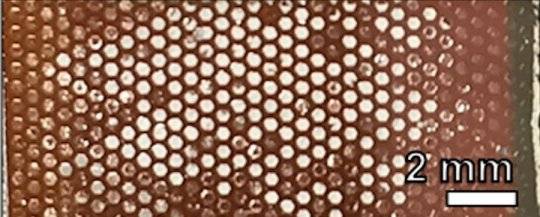New Solar Cell - Insect Compound Eye
[Outline] Packaging tiny solar cells together can make them similar to microlenses in insect compound eyes, which can help scientists solve the major obstacles to the development of perovskite photovoltaics and lay a foundation for a new generation of advanced photovoltaic power generation.

[Figure] Scaffolds in composite solar cells filled with perovskite after fracture testing.
In one study, Stanford University's research team adopted an insect-style design to protect the vulnerable perovskite photovoltaic material so that it does not deteriorate too quickly when it is affected by heat, moisture, or mechanical stress. Reinhold Dauskardt, professor of materials science and engineering of the study, said: "Perovskite is a promising, low-cost material that can convert sunlight into electricity, just like traditional silicon solar cells. But the problem is that Perovskite materials are extremely unstable and mechanically fragile. They can hardly survive the manufacturing process, and they can't grow their lives in the environment."
Most solar installations, such as roof panels, use a flat design. However, this method does not work well on perovskite solar panels. Nicholas Rolston, a graduate student who is co-director of the E&ES study, said: "Perovskites are the most fragile materials ever tested in our laboratory. The perovskite's brittleness is related to the salt crystal structure, which has Salt has similar mechanical properties."
Fly eyes
In response to the durability challenge, the Stanford team turned research ideas to natural organisms. Dauskardt explained: “We were inspired by the compound eyes of flying insects. It contains hundreds of tiny eyes. It has a beautiful honeycomb shape built in. If you lose one part, the other part will still work, and each part will be very fragile. They are easily shielded by surrounding scaffolding walls."
The researchers used compound eyes to make a composite solar cell that consists of a wide array of perovskite micro honeycombs, each encapsulated on a hexagonal stent that is only 0.02 inches (500 microns) wide. "The scaffold is made of a cheap epoxy resin that is widely used in the microelectronics industry," said Roston. "It is elastic to mechanical stress and it is less likely to break."
Tests conducted during the study showed that scaffolding had essentially no effect on the ability of perovskite to convert light into electrical energy. “We have almost the same power conversion efficiency in every small perovskite battery we get from flat-panel solar cells,†Dauskardt said. “So we achieved a significant increase in crack resistance without losing conversion efficiency.â€
Durability
However, can new equipment withstand the high heat and humidity of traditional rooftop solar panels? The researchers found that perovskite cells were exposed to temperatures of 185 degrees Fahrenheit (85 degrees Celsius) and 85% relative humidity for 6 weeks. In this extreme condition, the cells continued to generate electricity with higher efficiency.
Dauskardt and his colleagues have submitted tentative patents for new technologies. To increase conversion efficiency, they are investigating new methods for dispersing the light on the stent to the perovskite core of each cell. "We are very excited about these results," he said. "This is a new way of designing solar cells. These stand-cell batteries look cool, so real applications may bring some interesting aesthetic perspectives." E&ES Other coauthors of the study were Brian Watson and Adam Printz, postdoctoral researchers at Stanford University.
Stainless Steel Faucet,Stainless Steel Water Faucet,Lab Stainless Steel Faucet,Lab Stainless Steel Mixer Faucet
NARWILL IMPORT&EXPORT CO.LTD , https://www.narwill.com